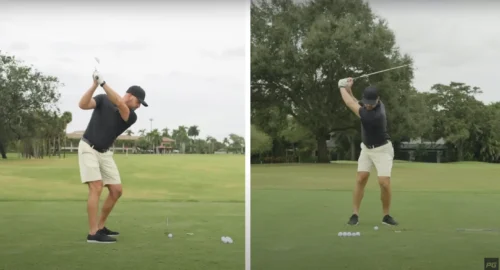
Are you just starting out and wondering how to build a golf swing like the pros? Beginners often struggle with consistency the most, and developing the proper golf swing from the start will greatly improve your overall golf scores as you enjoy the sport for years to come!
To achieve a proper golf swing, you’ll need to focus on five fundamentals above all else. Keep reading to learn these five keys to a powerful golf swing; plus, some easy drills to achieve more consistency.
Developing the Proper Golf Swing for Beginners
First off, it’s important to note that the golf swing is unique to every player, and there is no “one way” to swing the club. Tiger Woods was different from Jack Nicklaus, who was different from Arnold Palmer. But they all were able to “swing their swing” and play incredible golf.
However, there are some crucial aspects of the swing that all good players have in common. These five fundamentals are:
- A consistent grip
- Solid setup
- Tour takeaway
- Smooth tempo
- Proper weight transfer
Let’s get into how each of the five can help build a proper golf swing.
Golf Swing Fundamental #1: A Good Grip
Before sharing more advanced information about the swing, never forget about a good grip, as it’s the foundation of it all. Your grip influences the clubface’s position at impact, directly affecting the ball’s direction and flight. If you hit too many fades (or slices), chances are it’s from a weak grip.
There are three main ways to grip the club; overlapping, interlocking, or a 10-finger grip.
The overwhelming majority of professional golfers use a standard overlap grip. While some – including Jack Nicklaus and Tiger Woods – use an interlock grip.
Both grips can help with the first fundamental to a proper golf swing, but we recommend steering clear of a 10-finger grip. It’s quite uncommon and overall doesn’t produce the most consistent results.
Once you decide to overlap or interlock, make sure your lead hand is strong enough on the grip. Most golfers have a weak grip, which makes it harder to compress the golf ball and square the face at impact.
The sooner you can develop a consistent grip position, the sooner you can build a repeatable golf swing. This video from top instructor Eric Cogorno will help improve your grip fast.
Golf Swing Fundamental #2: The Setup Position
A grip is the first step to building a proper golf swing, but a good setup is a close second. What does a good setup look like?
When it comes to golf for beginners, consider the “big three” to create a consistent setup at address and set yourself up to swing like a pro.
- Stance: A proper stance based on the club you’re hitting will build a stable base to stay balanced throughout the swing.
- Posture: The right posture can help avoid injuries, improve the swing plane, and also help you stay balanced through impact.
- Alignment: Learning how to aim is one of the most important parts of golf because if you’re aimed incorrectly, it can lead to bad habits.
Golf Swing Fundamental #3: The Golf Swing Takeaway
Pros and amateur golfers have a very different takeaway from each other.
Amateurs often take the club inside on the backswing, while pros are more neutral or even slightly outside. The right takeaway makes it easier to drop the club in the slot, create lag, and build an in-out golf swing.
If you want a consistent golf swing, develop a consistent takeaway. The initial part of your backswing sets up the rest of the swing and gets the club on the right plane.
To develop a Tour takeaway, make sure to:
- Minimize lower body movement on the first part of your swing.
- Maintain width by keeping your lead arm straight to generate power.
- Have a one-piece motion to ensure your hands, arms, and shoulders move together.
If you need more help with your takeaway, the StraightAway training aid is the best tool to help. This small, portable training aid attaches to any club and provides feedback on your takeaway whether you’re hitting golf balls or making practice swings.
Golf Swing Fundamental #4: Develop Solid Swing Tempo
Did you know that most everyday golfers have a tempo that makes it nearly impossible to maximize power and sequence properly? Which might be leading to a quick, rushed transition?
Here’s the truth – professional golfers swing the club in about one second from start to finish. While recreational golfers take between 1.5 to 3.0 seconds for their golf swing. But if you timed each swing side by side, you would notice the backswing is what separates the two.
Pros take the club back much faster than amateurs and are able to generate significantly more swing speed. Which leads to more distance on every shot (every 1 mph increase with the driver is about 2 to 2.5 extra yards of distance).
While the first three golf swing fundamentals are key, don’t forget to swing with proper tempo. Most golfers try to take the club back slowly – almost guiding it – which leads to a rushed transition and lower swing speeds.
However, if you take the club back faster, it can lead to a smooth transition, better balance, and more power. Practice with a metronome on the driving range to develop a reliable rhythm to your golf swing.
Don’t forget, acceleration in the golf swing can only happen once – it better be at impact, not on your downswing.
Once you have the right fundamentals, check out these iron drills on our Performance Golf YouTube channel.
Golf Swing Fundamental #5: The Proper Weight Transfer
The final fundamental to a proper golf swing is a correct weight transfer. This step is crucial for generating enough power, maintaining balance, and compressing the ball.
Unfortunately, most everyday golfers leave their weight on their trail leg, spin out, and lose out on tons of power. Instead, you want to think about getting weight to your lead leg before the backswing is fully complete.
An effective weight transfer allows you to hit the ball with maximum force and maintain a proper balance. As you transition to the downswing, shift your weight back to your front foot. This movement should be smooth and natural, not abrupt.
Finish with most of your weight on your front foot, allowing your back foot to rise on your toe. A balanced follow-through indicates good weight transfer and likely a more consistent shot.
The Proper Golf Swing is Simple with These Five Fundamentals
Chances are, you’ll need to work on one or more of these five fundamentals to develop a proper golf swing. The good news is, you’re fully prepared to start practicing, and we’ve got tons more helpful tips to improve your golf swing faster here at Performance Golf.
If you’re interested in more in depth swing analysis, check out Swing Fix AI, a revolutionary way to learn about your golf swing without working with a coach. All you have to do is upload your swing to the Performance Golf app and let our proprietary software analyze it. It will give you a detailed breakdown of your game and a plan to improve quickly.

